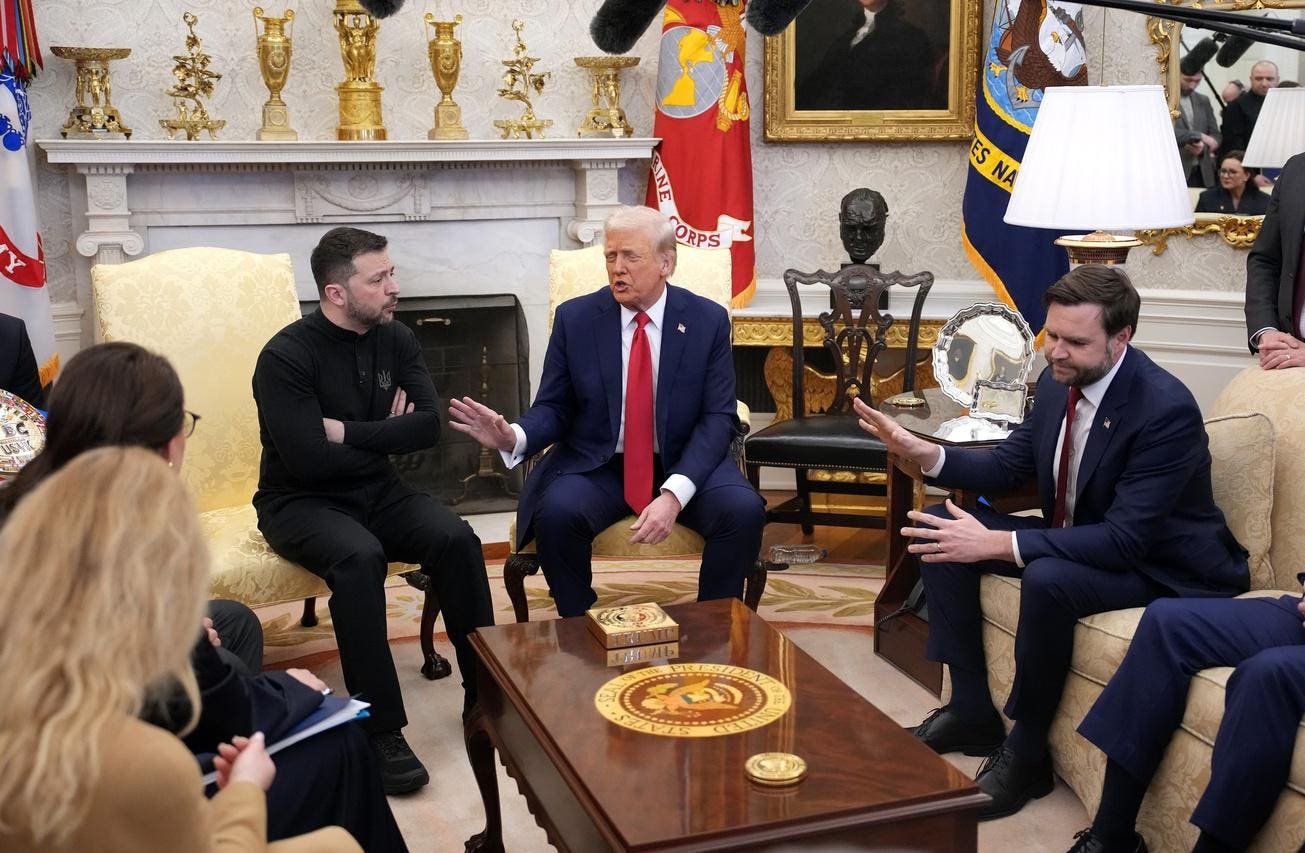Over the past six weeks, a recurring question has surfaced in my leadership development sessions with executives. It takes different forms, but the core inquiry remains the same:
“How do we reconcile the human-centered leadership you advocate with the leadership we see playing out on the global political stage?”
The Oval Office Showdown
Getty Images
I am neither a political commentator nor a global affairs analyst. My focus is leadership—what works, in which contexts, and why. That’s what I’ll explore here.
For years, I’ve championed Future Fit Leadership, which is fundamentally human-centric (an approach I explore more deeply in my book The Human Edge). This model is built on curiosity, purpose, openness, respect, and empathy—qualities that foster trust, drive collaboration, and encourage innovation. It’s about flattening the hierarchy to unleash the best thinking in the room and make smarter, faster decisions.
At the opposite end of the spectrum, we see a starkly different leadership model emerging. It’s embodied by President Trump and Vice President Vance in last week’s infamous Oval Office showdown with Ukrainian President Volodymyr Zelenskyy. That interaction relied on a win-lose mentality, rigid hierarchy, and domination. The underlying message?
“If I have more power, money, or strength than you, I will treat you as an instrument of my will. And you will comply.”
Why Does This Matter to Business Leaders?
The question arises because humans copy humans. We naturally look to mimic successful behavior. On the surface, Trump’s approach appears to be working. His power-driven, winner-takes-all leadership style is reshaping geopolitics and steamrolling his opponents. So, does this mean his approach is worth emulating in corporate life?
Absolutely not. Here’s why.
1. Leadership Is Always Context-Specific
A leadership style that thrives in one setting can fail spectacularly in another. Geopolitics has always been a ruthless game of power, often devoid of moral or ethical considerations. Even in a political administration with more polished rhetoric, international negotiations frequently play out as high-stakes, winner-takes-all battles.
However, this brand of muscular, aggressive leadership has a short shelf life in the corporate world—especially in complex, global organizations.
Consider Microsoft. Under Steve Ballmer (2000-2014), the company was run with a combative, competitive mindset. Ballmer dismissed emerging trends like cloud computing, and Microsoft became known for internal rivalries and resistance to change. Nadella (2014–present) by contrast, embraced a human-centered, purpose-driven leadership approach. He promotes curiosity, empathy, and collaboration, shifting Microsoft’s culture from competition to collaboration. His mantra?
“We are moving from a group of people who know it all to a group of people who want to learn it all.”
This leadership mindset contributed to the business becoming a leader in cloud computing, AI, and enterprise solutions. During Nadella’s tenure, Microsoft’s market cap increased from around $300 billion in 2014 to exceeding $3 trillion today, a roughly 10-fold increase. This huge growth is as much about a psychological evolution as technological innovation. The takeaway for corporate leaders: domination-based leadership may work in politics, but businesses thrive on agility, trust, and shared purpose.
2. Organizational Leadership Requires a Different Outcome
Great leaders ask:
What is the response do I want from the people who experience my leadership?
Trump and Vance demand absolute loyalty and subservience – as seen in their interactions with Zelensky. Because they hold all the cards, they will likely get it—or at least a facade of compliance.
But business leaders at all levels need something fundamentally different:
Commitment, not just compliance
Alignment, not forced submission
A workforce that is intrinsically motivated—not just responding to rewards and punishments
Human engagement is not solely motivated by juicy carrots and big scary sticks. It stems from people wanting to pursue the vision and goals of the leader and the organization they represent. Fear may drive short-term obedience, but it kills long-term engagement.
3. Businesses Need Agile Decision-Making
The organizations I work with aren’t just dealing with political and economic uncertainty—they’re grappling with AI, digitalization, and other megatrends accelerating the pace of change. To survive, companies must be:
Agile
Fast-moving
Decentralized in decision-making
This means pushing power away from the center and toward the front lines—empowering middle managers and frontline employees to think creatively and act decisively. That’s simply not possible under a fear-based, compliance-driven leadership model.
4. Innovation Requires Psychological Safety
If you want people to develop new ideas and ways of working, take risks, and think independently, they cannot operate in an environment of quaking subservience. Fear-based leadership might command short-term conformity, but it crushes initiative.
Smart leaders today understand that power is not something to be hoarded at the top—it’s something to be distributed strategically. Influence comes not from dominance, but from enabling others to succeed.
The Trump Playbook: A Dead-End Strategy for Business
President Trump’s leadership style may be effective in the political arena—for now. Part of the global anxiety and unease is uncertainty about what comes next. However, for business leaders, copying the Trump-Vance model is a path to irrelevance. The future belongs to those who:
Foster trust
Empower their teams
Build cultures of curiosity, resilience, and adaptability
The world is changing at an exponential rate. The new U.S. administration is accelerating this paradigm shift in some areas. Leaders must evolve and adapt—but they also must be careful about the lessons they take from the chaos unfolding around them.
Not all power leads to progress.
